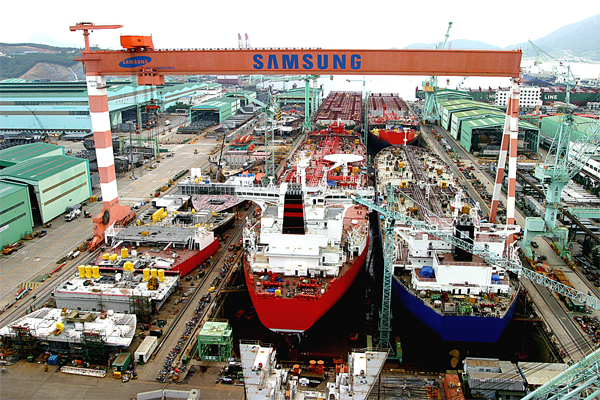The container ships on order rose by 23 to 201 last week, the biggest weekly gain in two years, boosting the outlook for Asian shipyards.
Some of the world’s largest container-shipping lines are ordering new vessels to address surging demand for ocean-cargo services.
Such ships globally transport about 80 percent of goods.
ZIM Integrated Shipping Services Ltd., an Israeli company that went public in late January, and Taiwan’s Evergreen Marine Corp. have announced recent purchases or chartering deals.
The 2016 bankruptcy of South Korea’s Hanjin Shipping disrupted supply chains for weeks and made it tougher to secure longer-term financing to purchase ships.
But the pandemic led to a surge in online demand for goods that allowed the carriers to charge rates up to four times higher for freight across the Pacific than a year ago.
Denmark’s A.P. Moller-Maersk A/S, the world's number one container shipping company, predicted last week that global container demand will increase 3 to 5 percent this year.
Orders for new container ships have increased by 115 since early October, equivalent to a new container capacity of over 1.1 million 20-foot equivalent units, or TEUs. It raised the total capacity order to about 2.7 million TEUs.
Shipping lines have ordered 21 vessels from South Korean shipyards since the start of the year. Some will be powered by liquefied natural gas in compliance with new international pollution standards.
Chinese shipyards have also benefitted.



 Japan PMI Data Signals Manufacturing Stabilization as Services Continue to Drive Growth
Japan PMI Data Signals Manufacturing Stabilization as Services Continue to Drive Growth  Asian Fund Managers Turn More Optimistic on Growth but Curb Equity Return Expectations: BofA Survey
Asian Fund Managers Turn More Optimistic on Growth but Curb Equity Return Expectations: BofA Survey  Trump Orders Blockade of Sanctioned Oil Tankers, Raising Venezuela Tensions and Oil Prices
Trump Orders Blockade of Sanctioned Oil Tankers, Raising Venezuela Tensions and Oil Prices  Singapore Growth Outlook Brightens for 2025 as Economists Flag AI and Geopolitical Risks
Singapore Growth Outlook Brightens for 2025 as Economists Flag AI and Geopolitical Risks  Silver Prices Hit Record High as Safe-Haven Demand Surges Amid U.S. Economic Uncertainty
Silver Prices Hit Record High as Safe-Haven Demand Surges Amid U.S. Economic Uncertainty  Wall Street Futures Slip as Tech Stocks Struggle Ahead of Key US Economic Data
Wall Street Futures Slip as Tech Stocks Struggle Ahead of Key US Economic Data  Chinese Robotaxi Stocks Rally as Tesla Boosts Autonomous Driving Optimism
Chinese Robotaxi Stocks Rally as Tesla Boosts Autonomous Driving Optimism  RBA Unlikely to Cut Interest Rates in 2026 as Inflation Pressures Persist, Says Westpac
RBA Unlikely to Cut Interest Rates in 2026 as Inflation Pressures Persist, Says Westpac  Asian Stocks Edge Higher as Tech Recovers, U.S. Economic Uncertainty Caps Gains
Asian Stocks Edge Higher as Tech Recovers, U.S. Economic Uncertainty Caps Gains  Asian Stocks Slide as AI Valuation Fears and BOJ Uncertainty Weigh on Markets
Asian Stocks Slide as AI Valuation Fears and BOJ Uncertainty Weigh on Markets  Australian Consumer Sentiment Slumps in Early December as Inflation Fears Resurface
Australian Consumer Sentiment Slumps in Early December as Inflation Fears Resurface  Oil Prices Rebound as U.S.-Venezuela Tensions Offset Oversupply Concerns
Oil Prices Rebound as U.S.-Venezuela Tensions Offset Oversupply Concerns  New Zealand Budget Outlook Shows Prolonged Deficits Despite Economic Recovery Hopes
New Zealand Budget Outlook Shows Prolonged Deficits Despite Economic Recovery Hopes  South Korea Warns Weak Won Could Push Inflation Higher in 2025
South Korea Warns Weak Won Could Push Inflation Higher in 2025  U.S. Dollar Steadies Near October Lows as Rate Cut Expectations Keep Markets on Edge
U.S. Dollar Steadies Near October Lows as Rate Cut Expectations Keep Markets on Edge  China’s November Economic Data Signals Slowing Industrial Output and Weak Consumer Demand
China’s November Economic Data Signals Slowing Industrial Output and Weak Consumer Demand 































